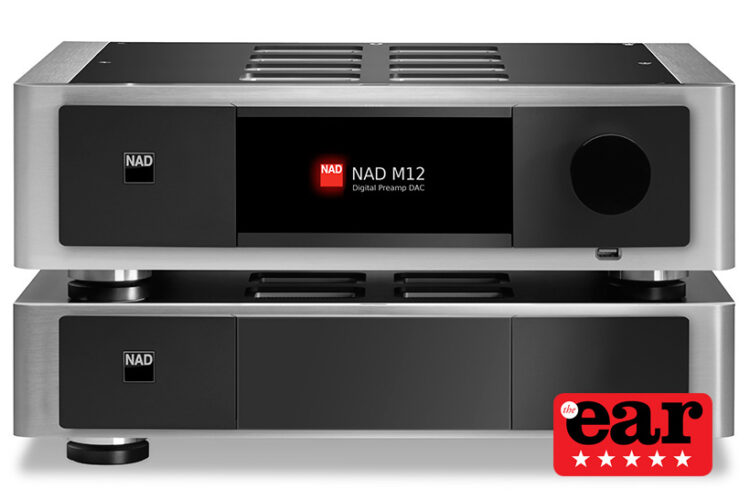René didn’t like class D amplifiers but that has all changed now that he’s heard this remarkable pairing from NAD. High resolution, power and features, what’s not to like?
Several years ago I considered New Acoustic Dimension, NAD for short, to be a high profile manufacturer specializing in mid-fi that also tried its hand in the high end with the Masters Series. Until the M2 digital amplifier that is, which opened my eyes to the fact that NAD has rather more to offer. This amplifier was followed by a streamer range consisting of the M50 digital music player, M51 D/A converter and the M52 storage system. And as a result I now see NAD as an innovative, high quality brand, worthy of a prominent place in the top drawer and one that also has a strong presence in the middle market. This view was underlined by the introduction of the M12 Masters Series digital preamp/DAC and the M22 power amplifier.
The first thing to do when setting up the M22 is to deactivate the automatic standby circuit. EU rules require devices to switch off after 30 minutes of standby, I’d rather switch them off myself. Under the lid the M22 has switch mode power supplies, these provide voltage and power to NC400 Hypex Ncore modules. NAD has customised these modules so that the output power of 250 Watts at 4 Ohms equals the output at 8 Ohms, with dynamic peaks of 600 Watts available for 2 Ohm loads.
Ncore is a technique in which the analogue signal is fed via Pulse Width Modulation to the speakers, without the need to convert the signal to digital. As PWM switching is extremely efficient, there is little cooling needed which keeps costs down despite the high power available. As with most power amps the M22 looks spartan. On the front is a backlit logo (dimmable), on top there’s stand-by switch. The back panel has RCA and XLR switchable inputs as well as a mains inlet. Very nice loudspeaker terminals, a trigger connection and a push button to adjust the brightness of the logo complete the picture.
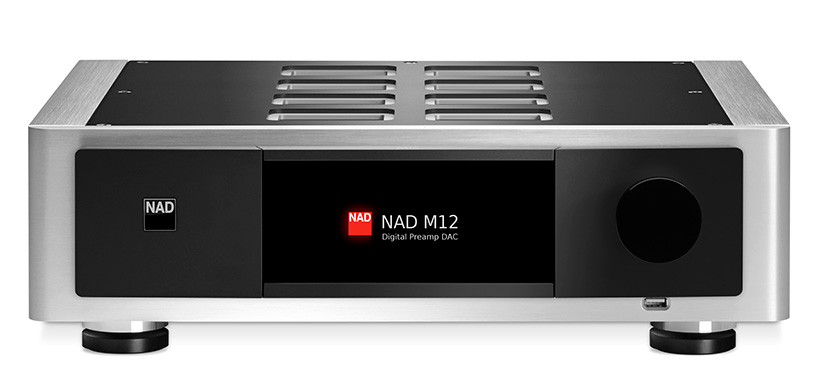
The same design, feet and stand-by switch are used for the M12 digital preamp. This converts analogue to PCM so that the signal can be manipulated in the digital domain before conversion back to analogue at the output. The technique that NAD uses corresponds to that in the M2 digital amplifier and the M51 DAC. Once the signal is digital it can be adjusted with a tone control and crossover frequencies can be set for subwoofers. For digital sources, of course, the A/D conversion is not necessary.
The M12’s input stage is modular, computer style expansion cards fit onto the back panel. This gives it an unprecedented degree of flexibility. Six slots are available and there are three filled in the review sample. Slot 1 contains the analogue inputs for RCA and XLR plus those for phono, the latter is adjustable in the software for MM and MC cartridges. Slot 2 has digital inputs for optical and coaxial S/PDIF connections plus AES/EBU on an XLR conection. In slot 5 are USB A and B connectors. Not yet available to is the DD-BluOS module that gives direct access to music files on a NAS drive to stream your music, it’s the equivalent of a Bluesound Node. A module with three HDMI inputs is also available. The back panel is attached to a main board with the following output connections: RCA and XLR out, digital out via optical and coaxial, two subwoofer outputs, trigger in/out, IR in and RS232 control. Finally there is the main switch on the back and the mains connection. The front has a hefty volume control knob next to a very nice touchscreen for making any adjustments. In practice, the touchscreen is extremely useful and well organized. Of course a remote is supplied so you do not always have to get up from your listening chair. Finally there is a front panel USB connection for USB sticks and the like.
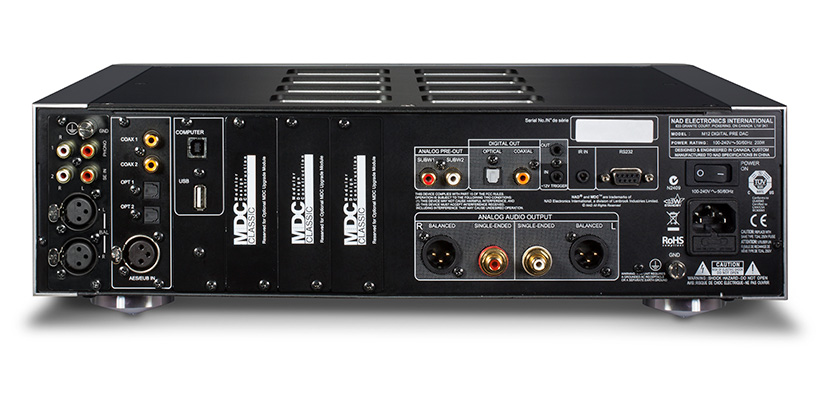
After making all connections, the set-up is as follows: Three analogue sources: a Magnum Dynalab tuner, a NAD M50 digital music player combined with an Aqua La Scala Mk II DAC and a Transrotor/SME/Transfiguration turntable combination with my own HAT phono amplifier. The M50 is also connected to the digital input of the M12. The speakers are PMC fact. 12 floorstanders. To compare the NAD products an Audia preamp and power amp are on standby. Because NAD itself says that the best results are achieved with a balanced connection between the M12 and M22 I use some VdH cables with XLR plugs.
Agreement
On the occasions that my wife is in the room and I’m listening, I normally only hear comments like “could you turn down the volume a bit”. So it was all the more astonishing to hear: "this sounds like a real piano", she used to play piano and knows what she's talking about. The pianist was Agnes Obel with her album Philharmonics, and I absolutely agree with my wife (it’s always a good policy – Ed.). The NAD combination made a big impression on me, not only with Agnes Obel, but with any music. What makes this combination so special? The main highlight is its extremely clean, detailed, rich and pure sound. I don’t mind some coloration if it benefits musicality, the phrase "too clean" should not come to mind. The thought came up with the M12 and M22 but it does not apply in the long run. To get back to Agnes, on the Philharmonics tracks it’s easy to hear that almost all the vocals are by Agnes, including the ones in the background and that’s not always so clear. The NAD pair has no problem opening up the sound and showing the finesse of the recording. It’s detailed in a way that I normally only expect from the best and most engineering driven brands, usually those aiming at much higher price points. The great thing is that this time the focus is not to reveal each and every little detail, but to make the detail a substantial part of the experience. That’s not all, the M22 power amp has a rock solid grip on the loudspeakers and is never short of breath, yet, the music remains complete at very low volume levels. When the tracks contain a lot of bass energy, the huge power reserve of the M22 is a blessing. Rarely have I heard an amplifier that supplies so much controlled energy at the lowest frequencies.
In praise of Hypex
Those familiar with my reviews might be surprised that I am praising a Hypex PWM amplifier, even though I often argue that this technology is wasted on me. So far, I've never been able to get used to PWM except in subwoofers. But improvements have been made over time, and the same sort of Hypex Ncore modules found in the Grimm Audio active speakers can be found inside the M22. Many other brands just adapt the Hypex technique, fit a power supply and put the result on the market. NAD is a little bit different. Tried and tested techniques from its own amplifiers are combined with Ncore to turn a technical solution into a musically capable one. Listen for yourself to Paul Stephenson's CD These Days. You won’t hear any sign of PWM character. Surrounded by acoustic instruments the singer stands out from the band, his voice is full of natural warmth and the stereo image is filled with sound. This pairing does have a limitation however, the M22 power amplifier has limited stereo image width. It reaches to the edge of the speakers, sometimes a little bit further, but never as far as the walls. If I never had another amplifier to play in the room I might have indexed this fact under the heading of precision, but I know that’s not true. The stereo image is open, deep and high, but seldom wider than the physical distance from speaker to speaker. Not with this CD, not with other kinds of music, not via analogue sources. I should mention however that the stereo image is entirely free from the loudspeakers, they disappear in a virtual sound bubble.
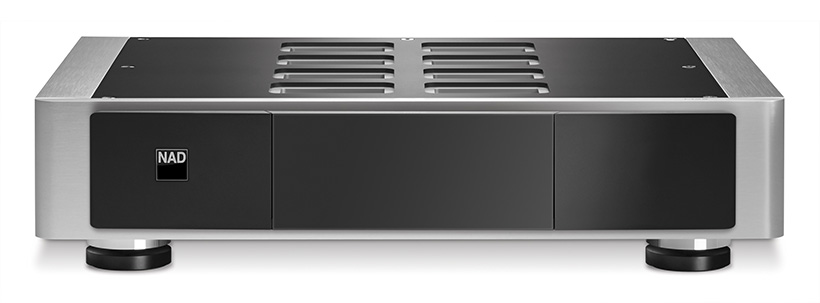
Accustomed as I am to an all analogue class A Audia amplifier combination ranking the NAD M12 and M22 is pretty easy, by comparison they are clear in nature, but not in a nasty way. For example, the opposite of the Audia’s sound is Devialet with its ADH solution which is closer to the technically perfect end of the spectrum. Don't get me wrong, Devialet does great things and those who have heard their SAM system will undoubtedly have been just as impressed as me. Yet I cannot imagine myself switching from old fashioned class A(B) to any kind of PWM, not even when it bares the Devialet logo. I had an M2 integrated for several years but in the end it had to go, so why embrace the M22? Maybe because of the clean sound, the musicality, the boundless deep bass or the intense pleasure of looking deep into the recording process.
Unnatural practices
It is an abomination for an analogue lover to first convert an LP to digital, then from PCM to analogue and finally to PWM analogue in the stages of the power amplifier. Yet that is exactly what I did with a Jheena Lodwick's LP Getting To Know You. Despite the investment in a horrifyingly expensive record player, a pricey cartridge and a precious phono amplifier is it worth it? Yes, oddly enough it is with the M12. Nothing is lost from the beautiful, smooth playback that characterizes pure analogue, it sounds different compared to analogue amplification, but not in the sense that you hear less, it’s not digital nor rougher/sharper/nasty/etc. For the record, I didn’t use the phono input on the analogue phono MDC module that was fitted to the M12, just its line level analogue input. My cartridge works in balanced mode and changing the cable is not an option. The M12’s internal A/D and D/A converters are of very high quality but without a bypass switch it’s impossible to determine exactly what is happening with the signal in these stages, so I just listened to the final result and it seemed to be without compromise. Not only with great recordings but also with old records bought in the seventies. Each LP remains a LP and does not turn into a CD within the M22. The sound remains beautifully free, natural, rich in detail and tight, provoking me to write compliment after compliment in my notes.
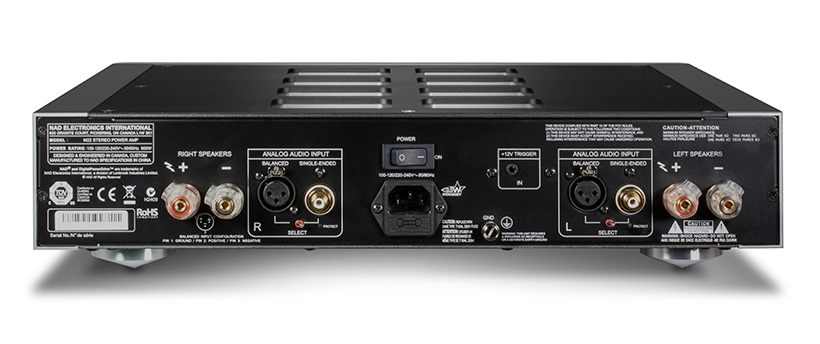
Sources were not limited to streaming and vinyl, an analogue tuner, a set-top box, a Blu-ray player and even the analogue output of my external DAC. The detail leads to greater intelligibility of radio and TV news broadcasts. Thanks to the energy in the bass, movies and TV with growling lows are terrifying. Even the character of my own highly esteemed DAC (which alone costs much more than the M12) stays intact. It is also interesting to hear what each component does in a different setting, such as connecting my Audia preamp to the M22 and vice versa; the M12 to my Audia power amplifier. First I connected my phono amp to the Audia preamp and the M22 and played the records again. The stereo image remains the same as it did with the M12 preamp and music stops at the edge of the speakers. My own preamp sounds softer than the NAD M12, making analogue sources a little tastier and more fluent. On the other hand that super tight bass gets lost in the chain. The attention to detail is less, all details remain, but they’re no longer highlighted. Music sticks closer to the speakers than I'm used to with the NAD M12/M22 combination or with an Audia pre/power set-up. This indicates that the NAD runs at peak performance when used with its natural partners, which is hardly surprising; synergy is after all a key factor in system building. Later the M12 is connected to the Audia Flight 50 power amp and this produces a stereo image that’s larger than with the M22. The character of the sound once again becomes softer, with detail still present but with less emphasis. A very pleasant combination with a very pleasant sound. Which would infer that it’s the Ncore technology that I find the least attractive. It’s a matter of taste and personal preference that I have put under the microscope in an AB test. Don’t forget that I used the NAD combination for several weeks purely for my own pleasure without a single complaint about PWM.

Conclusion
The NAD M12 and M22 are technically beyond reproach. The preamp is as flexible as possible, when you consider that input sensitivity can be changed, tone controls tweaked, sample rates for A/D conversion chosen and so on it is quite remarkable. The M22 is less extensive, but does produce a mountain of power, has RCA and XLR in, is energy efficient and very compact for a high power amplifier. So let’s get to how the NAD amps deal with music. In the first place they are very resolute which brings detail to the fore. Many such amplifiers have a tendency to get lost in technical precision but not the NAD, it puts music first. The amps are dynamic and tight on all fronts, especially in the low end, but also in the mid and high frequencies. I would not call them romantic and/or warm but when put together they are capable of giving pleasure, not for an hour, but for hour after hour. The insight you get into the recording, the finesse that is revealed, it all translates into pure enjoyment, no matter what kind of music you play. The NAD amps will appeal anyone that wants flexibility combined with massive power, the enthusiast who thinks green, the music lover with analogue and digital sources. The M12 preamp with the M22 power amplifier is for anyone who wants to get to the heart of the music.
Note: This review was originally published in Dutch on Hifi.nl


